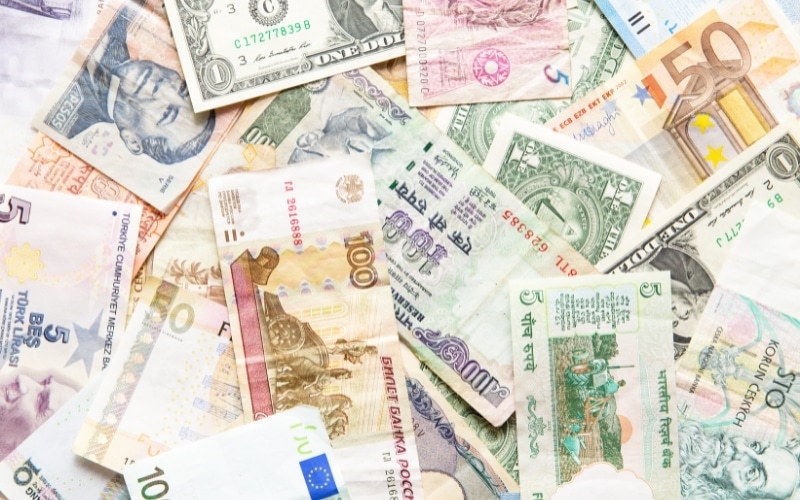
Trading currencies in forex markets is done in pairs. Each pair is quoted in two different currencies, following the conventional format base currency/quote currency. The base currency in the pair is the one that is either sold or bought. The quote currency is the one that tells us the going rate for the base currency. For example, if a USD/JPY is given an exchange rate of 110.57, it means that 1 U.S. dollar costs 110.57 Japanese yen.
Major, Minor, and Exotic pairs
In forex markets, currencies are paired as either majors, minors, or exotic. These pairs are classified according to the currencies’ countries of origin, their trade volumes, and liquidity in the market.
Major pairs
These currencies have the largest trading volume in global forex markets. Due to the U.S. dollar’s status as the global standard currency, every major pair must have it. There are three main pairs in forex. These are EUR/USD, GBP/ USD, and USD/ JPY. The underlying factor among majors is high liquidity, low volatility, and relatively low spreads. This makes them quite popular in forex trading.
Minor pairs
These are pairs that include some of the world’s most traded currencies but which do not have the U.S. dollar in their pairing. Examples include GBP/JPY, EUR/GBP, and EUR/JPY. Their volatility is comparatively higher than major currencies, but their trading volume is lower than the majors.
Exotic pairs
These pairs have a major currency and a currency from a developing nation. Their trading volumes are lower than minor and major pairs, but their volatility is higher. In addition, their spreads are comparatively higher. Examples of these pairs include USD/TRY (Turkish Lira), USD/KSH (Kenyan Shilling), GBP/HKD (Hong Kong dollar), etc.
When not to trade
It is advisable to avoid trading forex when liquidity is low. With low liquidity, volatility tends to be higher than normal, which may drive your account into losses. The risky times to trade are usually in the first few minutes of the market opening and around 1200 GMT.
You should also beware of the tendency of volatility to spike at the top of each hour and the last few minutes of each hour.
When should you trade?
Markets tend to have high liquidity within the first 3-4 hours of opening. It is easier to track trends and find retracements during these periods, which makes the sessions more stable.
What to consider when choosing pairs
1. Time of market activity
Seasoned traders know that currency pairs tend to fluctuate, depending on the time of day, with their peak hours being different.
For example, during the Asian session, the most active pairs include NZD/USD, USD/JPY, and AUD/USD. This is because economic data news usually comes out during this session.
The secret to getting the right time is finding out the interrelationship among the major trading sessions and integrating the impact of the economic calendar.
2. Level of volatility
This refers to the range within which a currency pair trades. The wider the range, the more volatile the currency pair is. As explained above, some pairs tend to be more volatile than others. Volatility and volume have an inverse relationship. Therefore, pairs with a high trading volume tend to be less volatile than those with low volume.
With high volatility, your potential profits are significantly higher, but the risk levels are also high. With that in mind, it is wise to place your stop loss further from the entry when trading volatile pairs. Similarly, low volatility translates to lower profit margins and reduced risk. Consequently, in this case, you should have your stop loss relatively closer.
3. Trading costs
Trading has its in-built costs that are unavoidable. Key among these costs are costs related to spreads and commission fees. Generally, major pairs have smaller spreads. The differences in spreads and commission fees can eat up a significant portion of your funds.
4. Correlation between pairs
At times, traders may want to increase their profit margins by transitioning from major pairs to exotic or minor currency pairs. This has an impact on the funds held in their accounts. This is where correlation comes in. Correlation refers to the degree of interrelationship between two elements.
The degree of correlation can determine how much you stand to gain or lose by transitioning from one pair to another. The pairs with close correlation are described as a positive correlation, while a weaker correlation is termed a negative correlation.
For example, GBP/EUR has a stronger positive correlation to GBP/USD than AUD/USD. If you transition to pairs with a strong positive correlation, your directional risk will be higher.
Bottom line
Choosing the right currency pair is an important consideration when you want to succeed in forex trading. Apart from that, other factors come into play when dealing with different currency pairs. Knowing these and combining them with good technical and fundamental analysis is invaluable to trading successfully.







